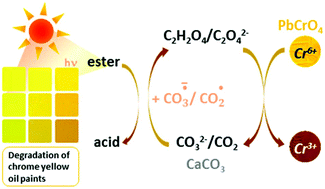当前位置:
X-MOL 学术
›
Photochem. Photobiol. Sci.
›
论文详情
Our official English website, www.x-mol.net, welcomes your feedback! (Note: you will need to create a separate account there.)
A little key to oxalate formation in oil paints: protective patina or chemical reactor?†
Photochemical & Photobiological Sciences ( IF 3.1 ) Pub Date : 2018-02-22 00:00:00 , DOI: 10.1039/c7pp00307b V. Otero 1, 2, 3, 4, 5 , M. Vilarigues 2, 3, 4, 5, 6 , L. Carlyle 1, 2, 3, 4, 5 , M. Cotte 7, 8, 9, 10, 11 , W. De Nolf 7, 8, 9 , M. J. Melo 1, 2, 3, 4, 5
Photochemical & Photobiological Sciences ( IF 3.1 ) Pub Date : 2018-02-22 00:00:00 , DOI: 10.1039/c7pp00307b V. Otero 1, 2, 3, 4, 5 , M. Vilarigues 2, 3, 4, 5, 6 , L. Carlyle 1, 2, 3, 4, 5 , M. Cotte 7, 8, 9, 10, 11 , W. De Nolf 7, 8, 9 , M. J. Melo 1, 2, 3, 4, 5
Affiliation

|
By means of synchrotron based techniques, we propose an integrated mechanism for the degradation of 19th century chrome yellow oil paints based on pigment reconstructions from historical recipes. We show that for certain paint formulations the darkening of these colours is triggered by the binder photodegradation which leads to the formation of calcium oxalate at the expense of the filler CaCO3, and the reduction of the chrome yellow pigment (Cr6+/Cr3+). Considering that calcium oxalate is formed as a thin superficial layer, that may prevent light absorption by the paint bulk, we discuss its role as protective patina.
中文翻译:

在油漆中形成草酸盐 的一点关键:保护性古铜色或化学反应器?†
通过基于同步的技术手段,我们提出的19退化的综合机制个世纪铬黄油漆基于从历史的食谱色素重建。我们表明,对于某些涂料配方,这些颜色的变暗是由粘合剂的光降解引发的,粘合剂的光降解导致草酸钙的形成,但以填料CaCO 3为代价,而铬黄颜料(Cr 6+ / Cr 3 +)。考虑到草酸钙形成为薄的表层,可能会阻止涂料主体吸收光,因此我们讨论了其作为保护性古铜色的作用。
更新日期:2018-02-22
中文翻译:

在油漆中形成草酸盐 的一点关键:保护性古铜色或化学反应器?†
通过基于同步的技术手段,我们提出的19退化的综合机制个世纪铬黄油漆基于从历史的食谱色素重建。我们表明,对于某些涂料配方,这些颜色的变暗是由粘合剂的光降解引发的,粘合剂的光降解导致草酸钙的形成,但以填料CaCO 3为代价,而铬黄颜料(Cr 6+ / Cr 3 +)。考虑到草酸钙形成为薄的表层,可能会阻止涂料主体吸收光,因此我们讨论了其作为保护性古铜色的作用。


























 京公网安备 11010802027423号
京公网安备 11010802027423号